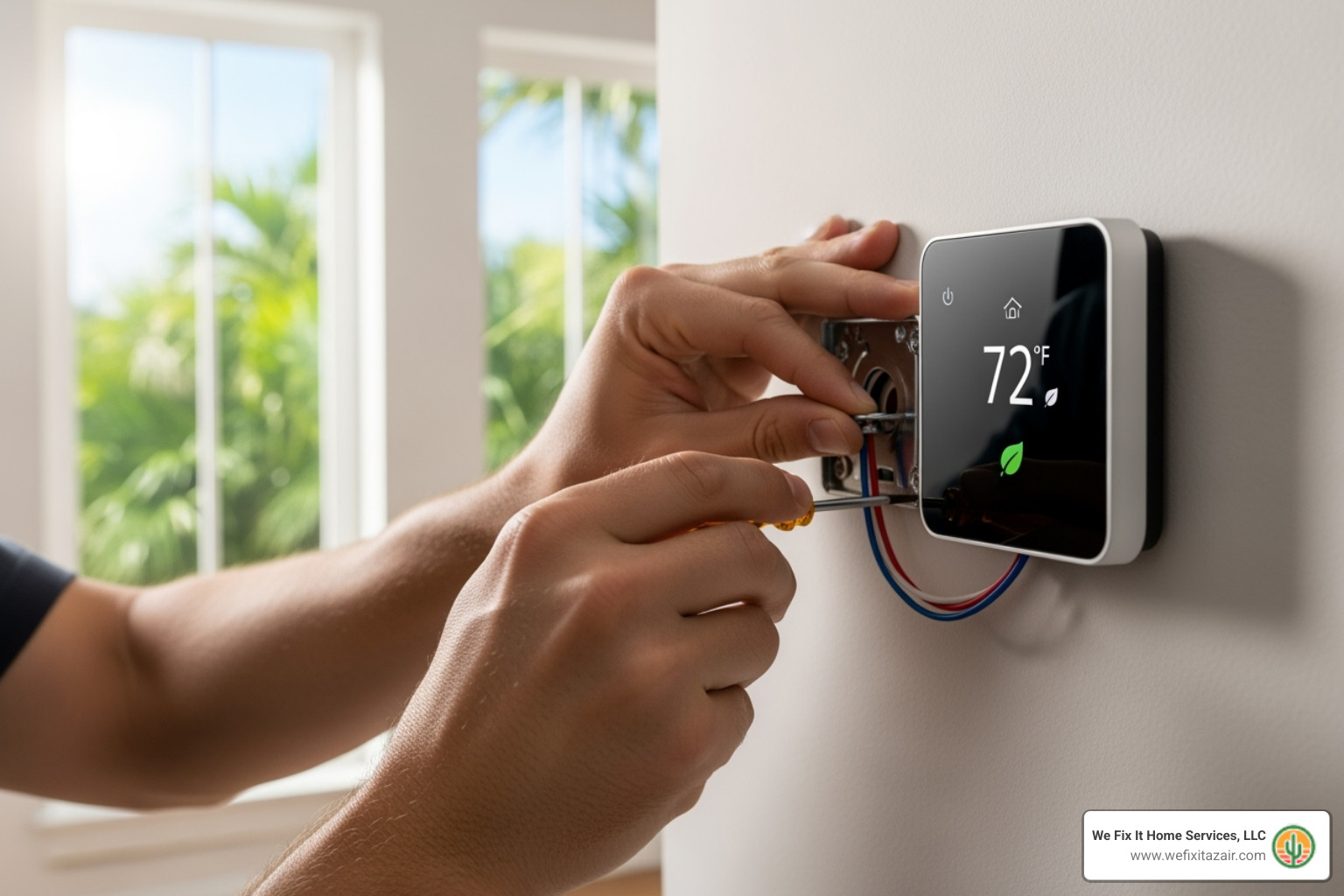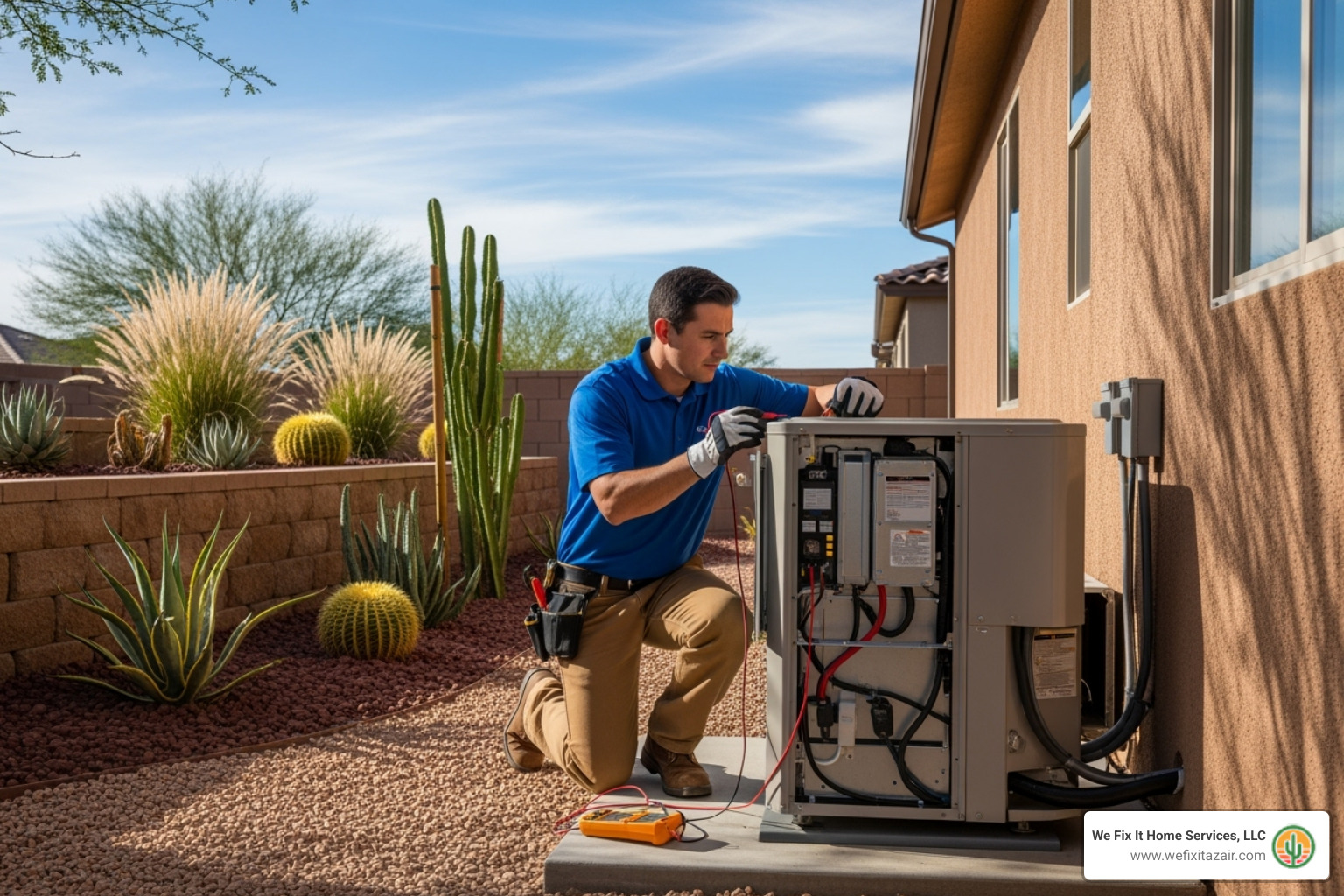Replacing Your AC Compressor: What You Need to Know
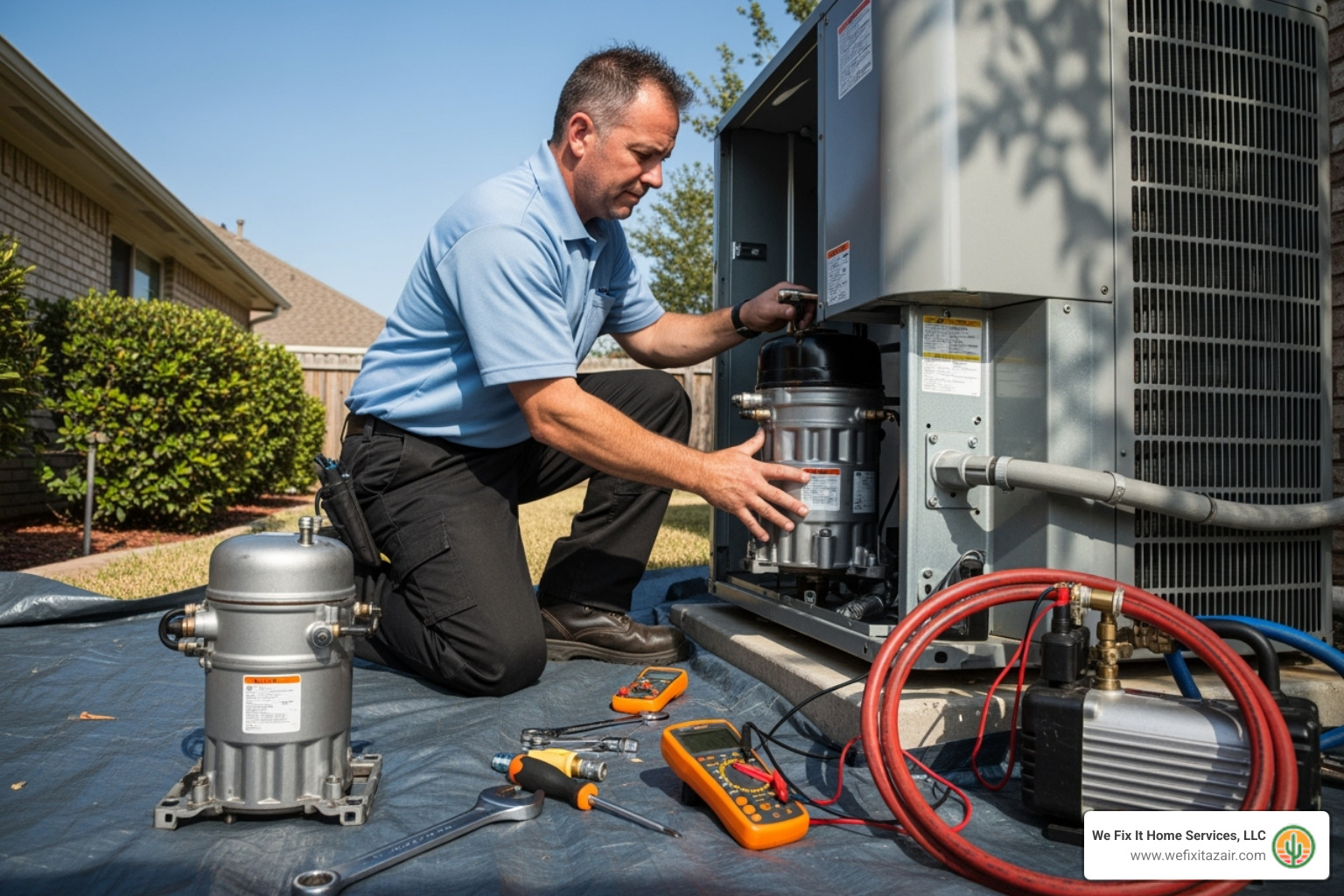
Understanding AC Compressor Replacement in Arizona's Extreme Heat
AC compressor replacement is a critical repair for your air conditioning system, especially in Arizona's brutal summer heat. The compressor is the heart of your AC, pumping refrigerant to enable the heat transfer that cools your home. When it fails, you need a solution fast.
Key Facts About AC Compressor Replacement:
- The compressor's job is to compress low-pressure refrigerant gas into high-pressure, high-temperature gas, which then moves to the outdoor unit to release heat.
- Replacement requires evacuating refrigerant, removing the old unit, and installing a new one.
- Professional service is essential due to refrigerant handling laws and safety risks.
- Signs of failure include strange noises, warm air, and frequent cycling.
In Arizona, where temperatures can exceed 115°F, your compressor is under enormous stress. This intense workload, combined with desert dust, makes failure a common issue. Understanding the replacement process helps you make informed decisions and avoid uncomfortable delays in emergency situations.
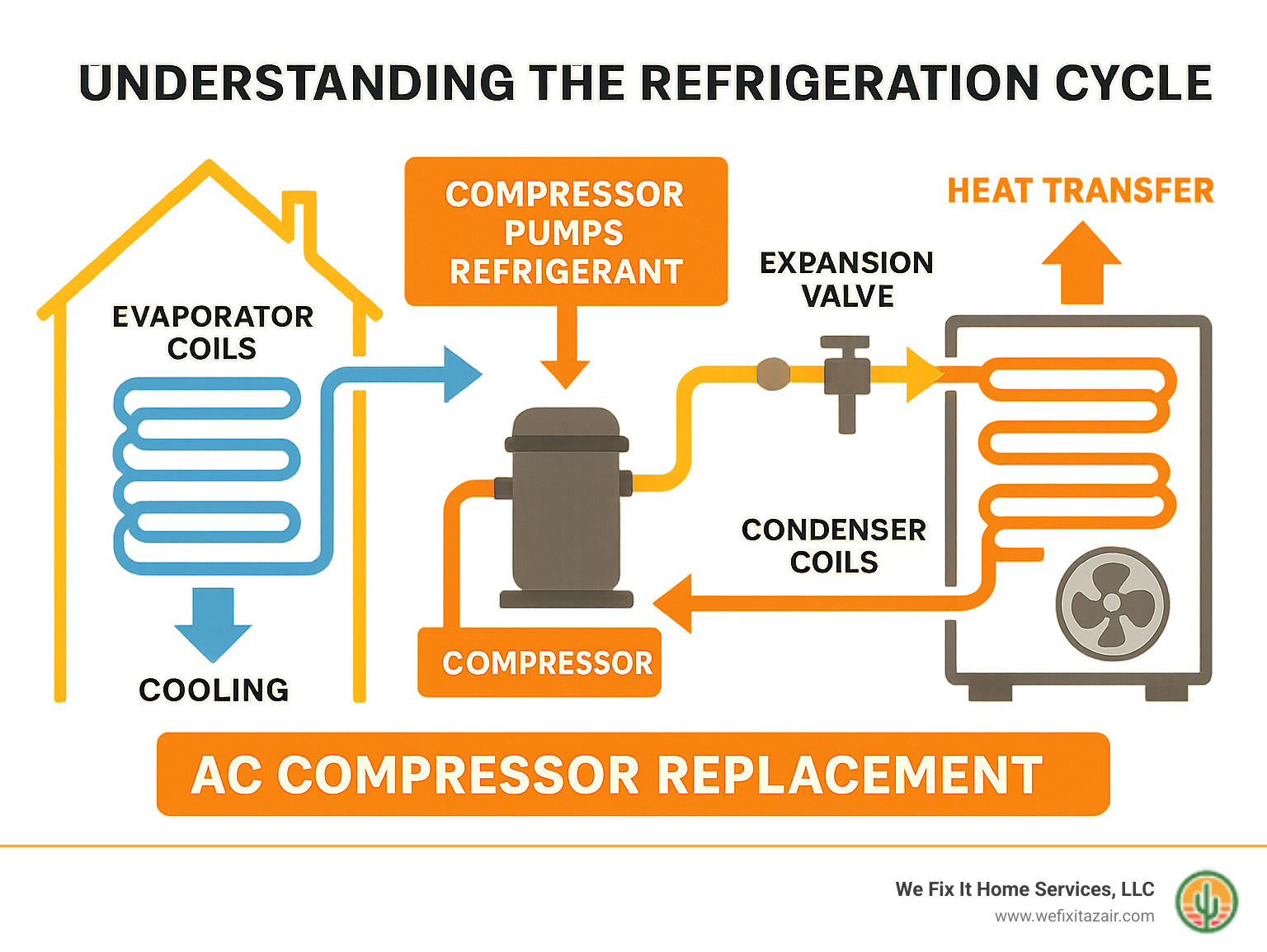
Telltale Signs Your AC Compressor is Failing
Your AC compressor will usually show signs of trouble before it fails completely. Knowing what to look for can help you take action before you're left without cooling in the Arizona heat.
Strange noises are a common red flag. Grinding or squealing sounds often mean internal parts are wearing out. Repetitive clicking when the system tries to start can point to electrical issues or a struggling compressor. A persistent buzzing sound may also signal electrical problems or an overworked motor. For more on this, see our guide on Why Air Conditioner Making a Buzzing Sound.
Warm air blowing from your vents is a clear giveaway. The compressor's job is to pressurize refrigerant to absorb heat from your home. If it can't do this, you'll get lukewarm air instead of a cool blast. If your AC struggles to cool your home below 80 degrees, it's a strong sign of a problem, as we cover in our article about AC Not Cooling Below 80 Degrees.
Frequent cycling, or short cycling, is when your system turns on and off in rapid bursts instead of running complete cooling cycles. This puts immense stress on the compressor and often indicates a serious issue. A failing compressor is a common cause, as the system tries to start, detects a problem, and shuts down repeatedly. Our guide on Why Your AC Cycles On and Off Tempe explains this further.
Tripping circuit breakers is a safety response from your electrical system. A failing compressor often draws more electricity than it should, causing the breaker to trip to prevent damage or fire. This isn't something to ignore; a compressor pulling too much power is likely damaged and needs immediate professional attention. Learn more in our article about Why Air Conditioner Tripping the Circuit Breaker.
Refrigerant leaks can also lead to compressor failure. When refrigerant levels drop, the compressor works harder and runs hotter, which can cause internal damage. Signs of a leak include ice on your indoor unit, hissing sounds, or oily spots near the outdoor unit.
Don't ignore these warning signs. Catching compressor problems early can save you from a complete AC compressor replacement and the discomfort of waiting for emergency repairs.
The AC Compressor Replacement Process: Why Professional Service Matters
AC compressor replacement is a complex repair involving hazardous materials and high-voltage electricity, making it a job for trained professionals. Attempting it yourself is risky and can lead to further damage. Professional service is essential for safety, system integrity, and compliance with federal laws.
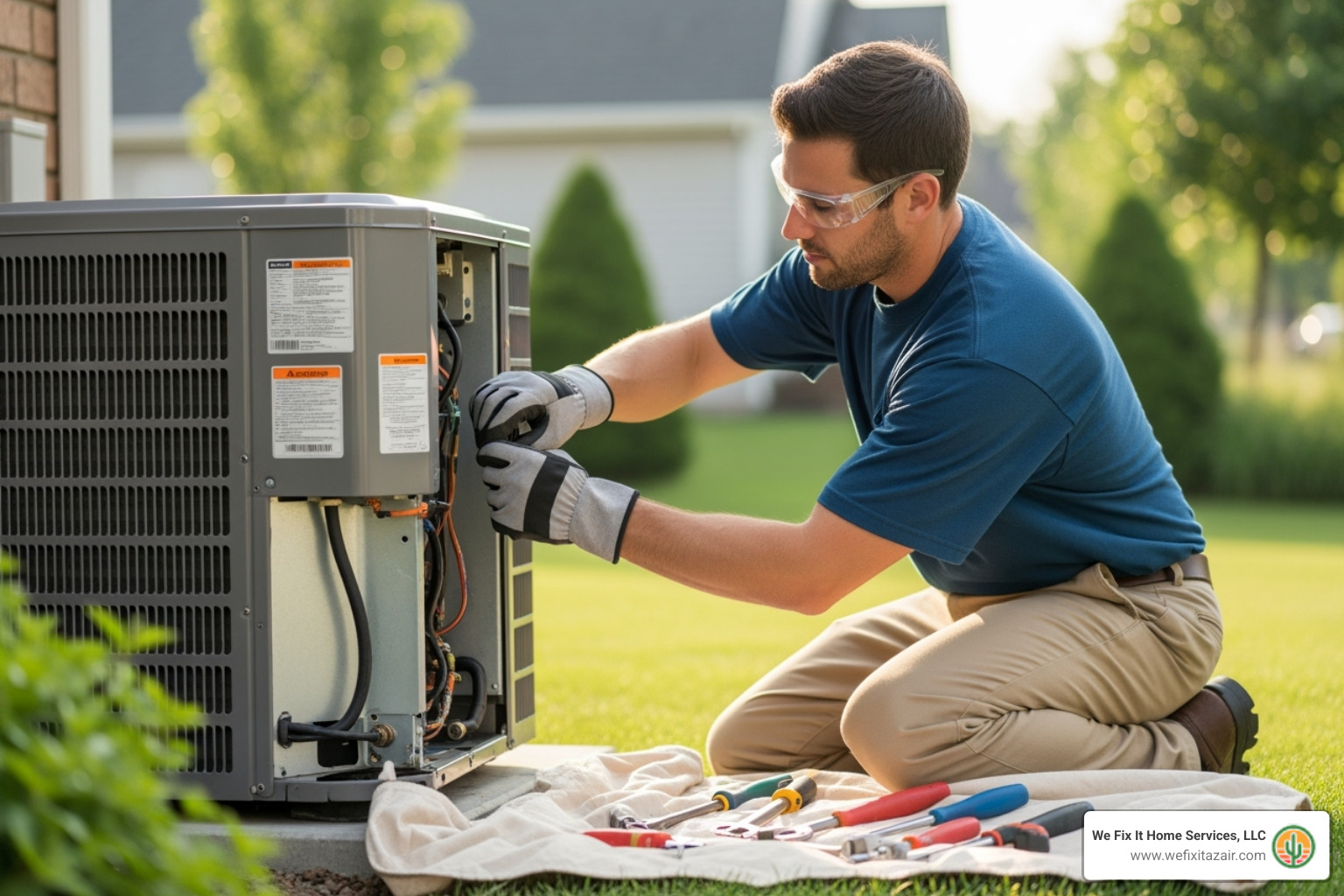
Essential Safety Precautions and Tools
Safety is the top priority. Technicians are trained to handle electrical hazards by ensuring the power is completely disconnected at the panel. They also manage refrigerant exposure risks. These chemicals are under high pressure and can cause frostbite or chemical burns, so personal protective equipment is mandatory.
Professionals use specialized tools that homeowners don't have, including:
- Manifold gauge set to monitor system pressures.
- Refrigerant recovery machine to safely capture old refrigerant as required by law.
- Vacuum pump to remove all air and moisture from the system.
- A complete wrench set for mechanical connections.
Step-by-Step Overview of a Professional AC Compressor Replacement
A professional AC compressor replacement follows a precise sequence:
- Power Shut-Off: The technician verifies the unit is completely de-energized.
- Refrigerant Recovery: Old refrigerant is safely removed and stored using a recovery machine.
- Old Compressor Removal: Electrical and refrigerant lines are disconnected, and the old unit is removed.
- New Compressor Installation: The new compressor is installed with fresh seals to ensure leak-free connections.
- System Evacuation: A vacuum pump is used to pull a deep vacuum, removing all air and moisture that could damage the new compressor.
- Refrigerant Recharging: The system is recharged with the exact amount of refrigerant specified by the manufacturer.
- System Testing: The technician runs the system to verify correct operation and pressures.
Why DIY is Risky: Legal and Technical Problems
Attempting a DIY AC compressor replacement is a bad idea for several reasons. Federal regulations require EPA certification for proper handling of refrigerants, with steep fines for releasing them into the atmosphere. System contamination is also a major risk; moisture and debris entering the system can form acids that destroy the new compressor. Furthermore, DIY installation will likely void your manufacturer's warranty and expose you to personal injury risks like electrical shock and chemical burns.

As we explain in Why Hiring HVAC Contractors Is Crucial, professional service protects you and your investment.
Key Factors in an AC Compressor Replacement
An AC compressor replacement isn't just a simple parts swap. Several factors, including your system's design and condition, determine the complexity of the job and the health of your entire cooling system.
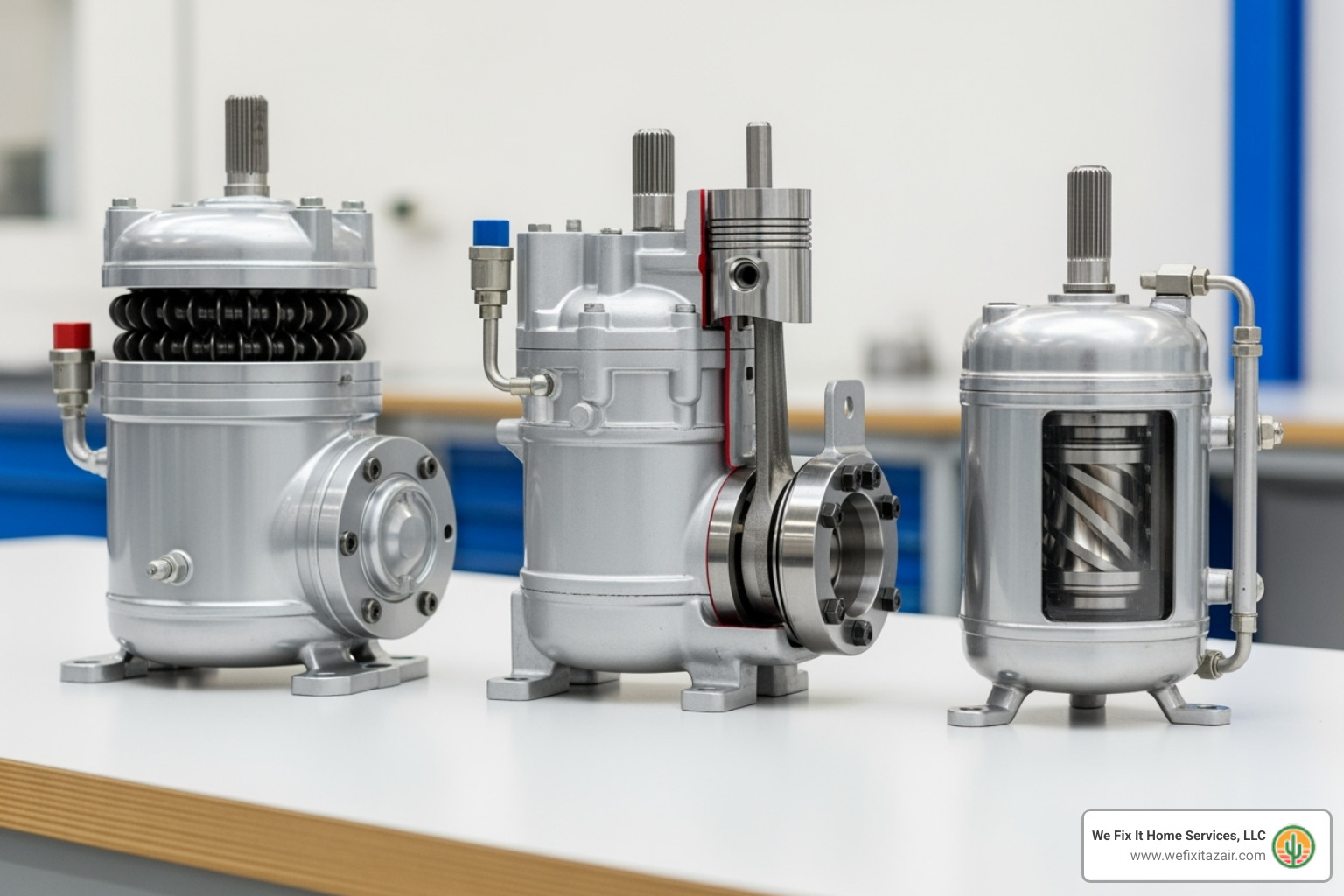
Compressor Type and System Size
The type of compressor in your outdoor unit affects the replacement process.
- Single-stage compressors run at 100% capacity and are the simplest to replace.
- Two-stage compressors operate at two levels (e.g., 70% and 100%), offering better efficiency and requiring more complex wiring.
- Variable-speed compressors continuously adjust their output, providing the best comfort and efficiency but requiring the most technical expertise to replace due to their advanced electronics.
System tonnage (cooling capacity) also matters. A larger system for a sprawling Arizona home requires a more powerful compressor and more substantial connections than a smaller unit for an apartment. Your home size and cooling load dictate the correct compressor size; a mismatch can lead to poor performance and premature failure. Learn how these parts work together in our guide to the 7 Most Important Components of an Effective Air Conditioning System.
Refrigerant Type and Its Implications
The refrigerant your system uses has major implications for an AC compressor replacement.
If your system uses older R-22 refrigerant (Freon), you're dealing with a substance that has been phased out by the federal government. The remaining supply is recycled, making it extremely expensive. This high cost often makes upgrading to a new system a more financially sound decision than replacing a compressor in an R-22 unit.
Modern R-410A refrigerant is the current standard, more environmentally friendly, and readily available. However, it operates at much higher pressures than R-22, meaning components are not interchangeable. You cannot use R-410A in an R-22 system. The Freon phase-out is a key reason why system compatibility is so important.
The Ripple Effect of a Failed Compressor
A failed compressor can cause widespread damage. A catastrophic failure, known as compressor burnout, can release metal debris and acidic compounds into your refrigerant lines. This system contamination can clog and damage other critical components like the evaporator and condenser coils.
Because of this contamination risk, a professional replacement often includes replacing the filter-drier, a component that traps moisture and particles. In severe cases of burnout, a full line set flushing is necessary to clean the refrigerant lines and protect the new compressor from immediate damage.
This is why a proper AC compressor replacement is more than just installing a new part; it involves assessing the entire system's health to ensure a lasting repair. For more on this, see our article on Addressing AC Compressor Failures in Glendale.
Repair or Replace? Making the Right Decision
When your compressor fails, you face a big decision: invest in an AC compressor replacement or replace the entire system? The right choice depends on your system's age, condition, and efficiency, and it's a key long-term investment in your home's comfort.
When to Consider a Full AC Replacement
Sometimes, replacing the entire AC unit is a wiser financial decision than just replacing the compressor. Here are the key factors to consider:
| Criteria | Compressor Repair | Full System Replacement |
|---|---|---|
| Unit Age | Generally considered for units less than 10 years old. | Recommended for units 10-15 years or older. |
| Repair Scope | Isolated compressor failure, no widespread system contamination. | Compressor failure with significant contamination, or multiple failing components. |
| Refrigerant Type | Unit uses modern R-410A refrigerant. | Unit uses outdated R-22 refrigerant (Freon). |
| Efficiency | Repair maintains existing efficiency, which may be lower than new units. | Opportunity to upgrade to a significantly more energy-efficient system. |
| Long-Term Reliability | Extends life of current system, but other components may soon fail due to age. | Provides new warranty, improved reliability, and peace of mind for years. |
Age is a major factor. If your AC is over 10-15 years old, it's nearing the end of its typical lifespan. Replacing the compressor might be a temporary fix before another major component fails.
The refrigerant type is also critical. If your unit uses outdated R-22 refrigerant, the high cost and scarcity of Freon make a full system replacement a more practical long-term solution.
Upgrading also offers a chance to improve energy efficiency. Modern units are far more efficient than older models, and the monthly savings on your utility bills can be substantial. Understanding What Does SEER Actually Mean can highlight the potential savings. Finally, if you've had frequent breakdowns, it's a sign your system is unreliable and replacement is likely the best option. Our AC Replacement Guide for Homeowners offers more guidance.
The Importance of Your System's Warranty
Before deciding, check your warranty. Compressor warranties often last 5-10 years and can significantly reduce your out-of-pocket cost. To check your coverage, find your unit's serial number, which can usually be found on a sticker on the outdoor unit. Then, visit the manufacturer's website and use their warranty lookup tool.
Understand what's covered; many warranties cover the part but not the labor. Even so, this can make a repair much more affordable and influence your decision. If you can't find the information, check your original paperwork or contact the company that installed the system.
Preventing Future Compressor Failure
Just like a car's engine, your AC compressor needs regular care to ensure a long life and avoid another costly AC compressor replacement. A few preventative steps can make a huge difference.
Regular air filter changes are crucial. A clogged filter forces your system to work harder, putting extra strain on the compressor and causing it to wear out faster. Change your filters every 1-3 months, especially during Arizona's hot summers.
Your outdoor unit needs attention too. Keep the area around your condenser unit clear of leaves, grass clippings, and other debris. This buildup traps heat, forcing the compressor to work harder. Ensure there are at least three feet of clear space around the unit for proper airflow, so avoid planting shrubs too close or storing items against it.
The most effective step is to schedule professional tune-ups. Annual maintenance allows technicians to catch small problems before they become major failures. During a tune-up, a technician will check refrigerant levels, clean critical components, and inspect electrical connections, all of which protect your compressor. Regular maintenance also keeps your system running efficiently, saving you money on energy bills. Our AC Maintenance Tips to Keep System Running provides more details, and you can learn about the ideal schedule in our guide on How Often Should You Service Your Air Conditioner.
These simple measures give your AC compressor the best chance to serve you reliably for years.
Frequently Asked Questions about AC Compressor Replacement
When your AC fails in the Arizona heat, you need straight answers. Here are the most common questions we hear from homeowners about AC compressor replacement.
How long does a typical AC compressor last?
Most AC compressors have a lifespan of 10 to 15 years. However, in Arizona's extreme climate, compressors work much harder, which can shorten their lifespan. Regular professional maintenance is the best way to maximize the life of your compressor and get the most out of your investment.
Can a bad compressor damage other parts of my AC system?
Yes. A severe failure, known as a "burnout," can release acidic residue and metal debris into the refrigerant lines. This contamination circulates through the system and can clog or damage other vital components like the evaporator coil, condenser coil, and expansion valve. This is why a professional assessment after a failure is so important; a system flush may be needed to protect the new compressor.
What is AC short cycling and is it a bad sign?
Short cycling is when your AC system turns on and off in short, frequent bursts instead of running for longer, complete cycles of 15-20 minutes. It is a very bad sign. This pattern puts immense strain on the compressor, as the startup phase is the most stressful part of its operation. Constant starting and stopping will wear out the compressor much faster. If your unit is short cycling, it needs immediate professional attention to diagnose the cause and prevent a complete compressor failure.
Conclusion: Trust the Experts for Your AC Needs
In Arizona's extreme heat, your AC compressor is essential for keeping your home safe and comfortable. As we've covered, AC compressor replacement is a complex job that should only be handled by trained professionals. The risks of improper installation—from system contamination to safety hazards—are too high for a DIY attempt.
At We Fix It Home Services, LLC, we understand the urgency when a compressor fails. Our NATE-certified technicians use their extensive training and modern diagnostic tools to get your system running efficiently again. As a family-owned company serving Pinal and Maricopa Counties, we are committed to providing honest, high-quality service.
We don't just replace parts; we diagnose the root cause of the failure to prevent future issues. Whether you need a repair or a full replacement, we offer reliable solutions backed by extended warranties and financing options.
If your AC compressor is showing signs of trouble, don't wait for a complete breakdown. For expert diagnostics and professional AC compressor replacement services, contact our team for reliable AC Repair in Mesa, AZ. We're here to keep your home cool, no matter how hot it gets.




















Customer Testimonials






















